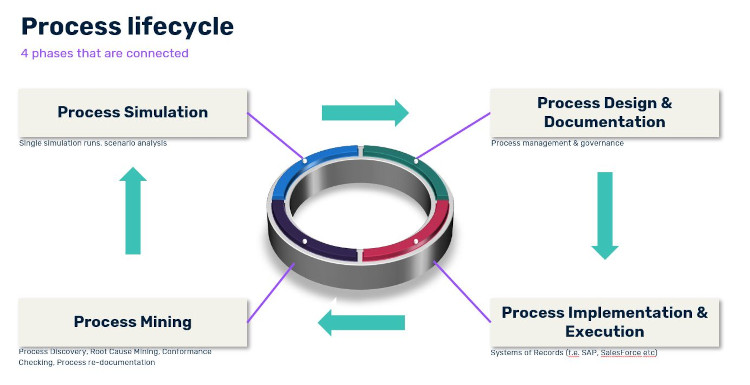Already the last episode on my weekly blogs on process mining (at least, for now, you never know if I might come back to it) and this week I would like to share my thoughts on the embedding of process mining into your wider business process management practice. I was triggered by an article I stumbled across on LinkedIn (this one) with the exciting title: BPM is not dead! The reason why I triggered me, and I’ve written on this before, is that the perception a lot of people have with the term BPM still dates back from the late nineties (yes, in the previous millennium) or early 00’s. At that time, BPM was ruled supreme by IT companies that had the ambition to be able to document a process and without much ado automate it as well. Later this technology actually was labeled BPMS, but the general population did not catch on to that.
So, before I go into embedding process mining into BPM, let me define BPM real quick: BPM is a management philosophy where the Business process is the central construct. It’s not a tool, although it typically is supported by a BPM platform. It is a collection of procedures, protocols and processes to ensure that an organization is in full control of the documentation, management, governance and optimization of it’s business processes. If you would have a narrow view on BPM, you typically could not care less about the optimization part and you focus completely on the documentation & management part. For a long time this was the general perspective on BPM as well and constantly led to discussions whether or not processes should be modeled in PowerPoint, Visio or ARIS (basically the mother of all real BPM tools). Slowly but surely, the wider definition of BPM (including the optimization part) is gaining momentum and we have moved past the earlier mentioned discussion on where to document processes. This means that the BPM community has been looking into other technologies in order to fill in the part of the optimization and some of these technologies include RPA, Task Mining and, of course, Process Mining.
Now, why is it, to my opinion, so important to embed process mining (but this applies to any process optimization technology) into a wider process management practice? In the picture below you can see a conceptual visualization of the lifecycle of a process.
For the sake of simplicity I assume that we are going to start with the design and documentation of a process, which typically takes place in a BPM tool and since BPM platforms are not execution platforms, these business processes are actually implemented into transactional applications (or systems of record as they are sometimes called). Based on the event logs from these transactional systems, you can then engage in process mining (or task mining if you want, but let’s stick to the process mining for now) and discover how the processes have actually been executed. However, you can do more with process mining, for example:
- Mine for root causes of certain symptoms,
- Check the conformance to a reference model, or
- Document a process variant directly in your BPM platform
Once you’ve mined the process and ran some analyses on it, you will find, without a doubt, points for improvements. The next step can then be to make some changes to the documented discovered process (see bullet 3 above), make some changes and subsequently simulate the improved process (to find out if it indeed will give you an improvement or not). Should this simulation be satisfactory, you probably (and hopefully) then adjust your already documented reference model in your BPM platform and perform the necessary changes in your transactional systems. The whole cycle then repeats itself so you will also see the effects of the improvement in your dashboards.
Now, what I described above (with one exception) can be done when you have two separate tools to run process mining and to run your BPM efforts, however there are a couple of reasons to consider embedding it in your BPM platform:
- You want to be able to show the results of process mining right next to the document process you have mined, in order to prevent unnecessary switching between windows. Think back to my previous blog (link here) where I showed an example of this.
- Automatic creation of discovered processes that are worth wile to document, avoiding a lot of manual export / import activities
- The reduction of complexity for your IT organization if you can run BPM and process mining from the same platform
- The simplicity for the end users of your BPM platform to have everything in one place
After all, the ideal situation is that your BPM team or Center of Excellence does not have to worry about different technologies (with slightly different methodologies, jargon, filters etc) and are able to manage the companies business processes from one central platform. Forrester did a study to the benefits of perhaps the most famous BPM platform out there: Software AG’s ARIS10 platform and found that the ROI exceeded 300%! So every dollar or euro you invest in this platform came back 3x in benefits. You can find that study right here.
I leave you with that thought and I will start contemplating on the topic for the next month’s My Week In BPM blogs, which is going to be centered around Transformation and how BPM supports that.
Ciao, Caspar


.JPG)
